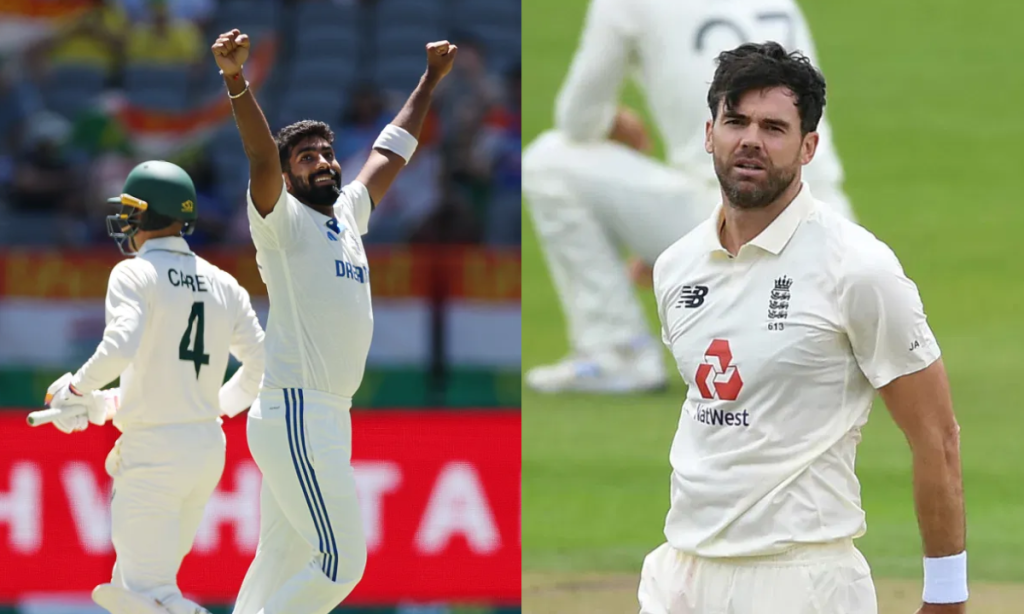James Anderson’s achievement of being the first fast bowler to reach 700 Test wickets is a testament to his longevity, skill, and resilience.
This monumental record now stands as a challenge for the current generation of fast bowlers, who, with their talent and dedication, could aspire to surpass this mark.
Here, we delve into the prospects of three such pacers who can challenge James Anderson’s Big Feat: Jasprit Bumrah, Kagiso Rabada, and Mitchell Starc.
Jasprit Bumrah
Jasprit Bumrah has quickly risen to prominence in international cricket with his unique bowling action and lethal accuracy.
With 205 Test wickets as of his last match in the Border-Gavaskar Trophy against Australia, Bumrah has shown he possesses both the skill and the temperament to excel in Test cricket.
His ability to swing the ball both ways, combined with his mastery over yorkers and bouncers, makes him a formidable opponent for any batsman.
However, Bumrah’s journey has not been without its hurdles. His recent struggle with a back spasm during the series against Australia is a reminder of the physical toll that fast bowling takes.
Yet, his recovery and return to form are eagerly anticipated, as his current tally and strike rate suggest he could be on track to challenge Anderson’s record if he manages to maintain his fitness.
Bumrah’s approach to fitness, including his modified run-up and action to preserve his back, indicates a long-term strategy to prolong his career, which is crucial for amassing the kind of wickets Anderson has.
Kagiso Rabada
Kagiso Rabada, with 327 Test wickets under his belt, is another pacer with the potential to challenge Anderson’s record.
At a relatively young age, Rabada has already established himself as one of the best fast bowlers in the world, known for his pace, bounce, and ability to bowl long spells.
His performances in varying conditions, from South African pitches to the subcontinents, showcase his adaptability, a key trait for accumulating wickets over a long career.
Rabada’s consistency, especially in taking wickets in crucial phases of the game, has been his hallmark.
His bowling average and strike rate are among the best of his contemporaries, suggesting a bright future if he can keep injuries at bay.
The key for Rabada will be to manage the physical demands of bowling at high speeds and to maintain his intensity over the next decade or so.
His leadership in the South African bowling attack, especially after the retirement of stalwarts like Dale Steyn, puts additional responsibility on him, which could either be a test of endurance or a catalyst for greater achievements.
Mitchell Starc
Mitchell Starc, with 382 Test wickets, represents Australia’s rich tradition of pace bowling.
Starc’s left-arm pace, combined with his ability to swing the ball at speeds often exceeding 145 km/h, makes him a fearsome prospect for any batting lineup.
His record in Test cricket, particularly in home conditions, shows his prowess, but it’s his performances in England and Asia that have shown his versatility across different conditions.
Starc’s journey, unlike Bumrah or Rabada, has been somewhat marred by injuries, which have kept him out of games at critical times.
However, his return from these setbacks has often been marked by spectacular performances, indicating his resilience and commitment to the game.
For Starc to challenge Anderson’s record, maintaining this return from injuries and leveraging his experience in various conditions would be vital.
His role in Australian cricket, both in terms of wickets taken and his impact on the game’s momentum, suggests he could have a few more years of significant contributions if fitness permits.
The Road Ahead
The path to surpassing 704 Test wickets is fraught with challenges, including physical fitness, maintaining form over a long period, and the natural evolution of cricket where conditions and rules might change.
For Bumrah, Rabada, and Starc, the journey involves not just physical preparation but also a deep understanding of the game’s strategic elements. Their ability to adapt to different teams, conditions, and match situations will be crucial.
Each of these bowlers brings something unique to the table – Bumrah’s unconventional action and precision, Rabada’s raw pace and bounce, and Starc’s left-arm swing.
Their success will also depend on how they evolve their game with time, learning from predecessors like Anderson, who adapted his bowling to remain effective even as his pace waned.
Moreover, the support from their respective cricket boards in terms of workload management, recovery, and strategic rest periods will play a significant role.
Cricket has seen an increased focus on player health, but the demands of international cricket are ever-increasing, making this balance even more critical.
While Anderson’s record stands as a towering achievement, the likes of Bumrah, Rabada, and Starc are not just competing against numbers but against the wear and tear of time, the evolution of batting techniques, and their own physical limits.
If they manage to navigate these challenges, we might witness the emergence of a new record holder in Test cricket’s pantheon.
However, their journey will be as much about personal triumph as it is about the narrative of cricket’s ever-evolving saga.

